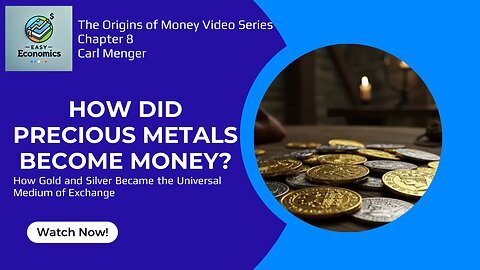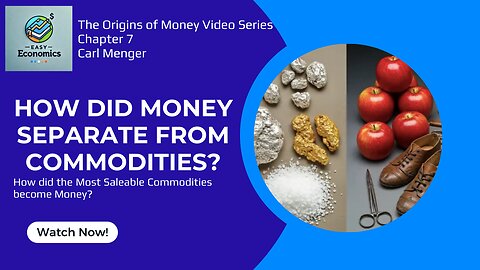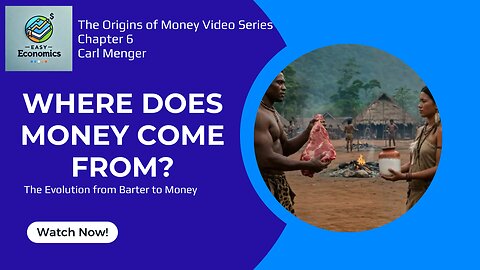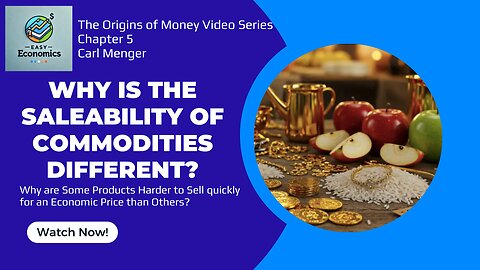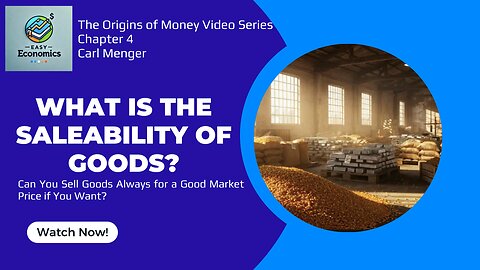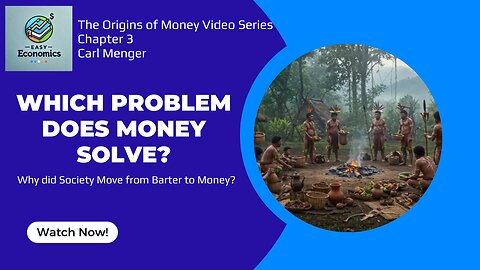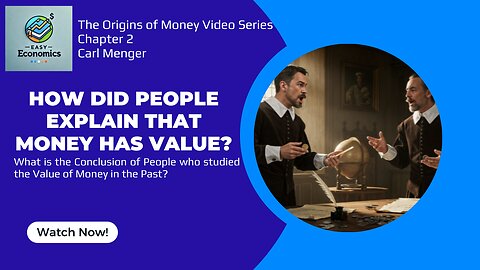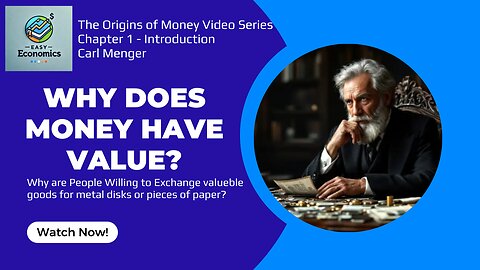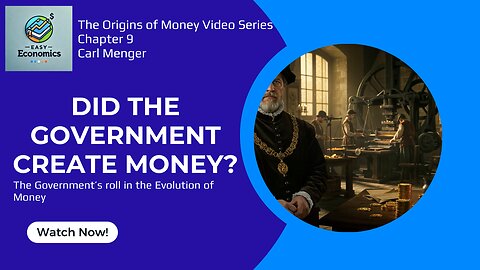
The Origins of Money by Carl Menger Video Series
9 videos
Updated 8 months ago
Money is one of the most important foundations of modern society, but where did it come from? In The Origins of Money, Carl Menger explains how money wasn’t created by governments or rulers—it emerged naturally from human exchange. Menger, the founder of the Austrian School of Economics, argued that money developed because people needed a better way to trade goods and services. Before money, people relied on barter, which made trade difficult since both parties had to want exactly what the other offered. Over time, certain goods—like gold, silver, and salt—became more widely accepted because they were durable, easy to carry, and held value. These goods gradually became the first forms of money. Menger’s insight was that money is not a creation of the state, but a product of spontaneous order—a solution that emerged from the decisions of countless individuals. This playlist breaks down the key ideas in The Origins of Money into easy-to-understand videos, showing how Menger’s theories still explain why certain forms of money work better than others and why money remains essential to a functioning economy. Whether you’re new to economics or looking to deepen your understanding, this series will help you see money in a whole new way.
-
The Origins of Money by Carl Menger Chapter 9 - The Influence of the Government on Money
 EasyEconomicsYou want to read the book? Get it here: https://amzn.to/4iJrkhR Watch the next video in this serie: Coming Soon Watch the video series from the start: https://rumble.com/playlists/SbtdSMVNrm0 Watch our video about Carl Menger: https://rumble.com/v61z0l2-carl-menger-the-father-of-austrian-economics-and-subjective-value.html Did governments create money—or did it emerge naturally? In this video, we explore Carl Menger’s view that money arose not from state authority, but from voluntary trade and social interaction. Precious metals like gold and silver became money because of their high saleability, long before any government gave them official status. However, sovereign powers later played a crucial role in refining money’s use by minting coins, maintaining weight standards, and regulating currency circulation. These actions built public trust and helped smooth complex trade. When multiple forms of currency caused confusion, governments intervened by legalizing specific forms of money and setting fixed exchange rates. But even then, they didn’t invent money—they merely shaped what already existed. Learn how the state’s influence supported, but did not originate, the institution of money. Questions Answered: -Did governments invent money or adopt it? -How did money exist before official laws? -What role did states play in coinage and standardization? -Why did governments step in when multiple currencies existed? -What is legal tender, and how did it evolve? -How did state actions build public trust in money? -Why were gold and silver chosen for official coinage? -What problems arose with competing currencies? -How did fixed exchange rates improve trade? -What was Carl Menger’s view on the origin of money? 00:00 - Introduction to the Influence of the Government on Money 00:09 - Money as a Social Invention 00:36 - The Emergence of Coins 01:10 - Addressing Currency Competition 01:42 - Government’s Role in Refining Money 02:00 - Closing #CarlMenger #AustrianEconomics #HistoryOfMoney15 views
EasyEconomicsYou want to read the book? Get it here: https://amzn.to/4iJrkhR Watch the next video in this serie: Coming Soon Watch the video series from the start: https://rumble.com/playlists/SbtdSMVNrm0 Watch our video about Carl Menger: https://rumble.com/v61z0l2-carl-menger-the-father-of-austrian-economics-and-subjective-value.html Did governments create money—or did it emerge naturally? In this video, we explore Carl Menger’s view that money arose not from state authority, but from voluntary trade and social interaction. Precious metals like gold and silver became money because of their high saleability, long before any government gave them official status. However, sovereign powers later played a crucial role in refining money’s use by minting coins, maintaining weight standards, and regulating currency circulation. These actions built public trust and helped smooth complex trade. When multiple forms of currency caused confusion, governments intervened by legalizing specific forms of money and setting fixed exchange rates. But even then, they didn’t invent money—they merely shaped what already existed. Learn how the state’s influence supported, but did not originate, the institution of money. Questions Answered: -Did governments invent money or adopt it? -How did money exist before official laws? -What role did states play in coinage and standardization? -Why did governments step in when multiple currencies existed? -What is legal tender, and how did it evolve? -How did state actions build public trust in money? -Why were gold and silver chosen for official coinage? -What problems arose with competing currencies? -How did fixed exchange rates improve trade? -What was Carl Menger’s view on the origin of money? 00:00 - Introduction to the Influence of the Government on Money 00:09 - Money as a Social Invention 00:36 - The Emergence of Coins 01:10 - Addressing Currency Competition 01:42 - Government’s Role in Refining Money 02:00 - Closing #CarlMenger #AustrianEconomics #HistoryOfMoney15 views -
The Origins of Money by Carl Menger Chapter 8 - How Gold and Silver Became Money
 EasyEconomicsYou want to read the book? Get it here: https://amzn.to/4iJrkhR Watch the next video in this serie: https://rumble.com/v6r9a7y-the-origins-of-money-by-carl-menger-chapter-9-the-influence-of-the-governme.html Watch the video series from the start: https://rumble.com/playlists/SbtdSMVNrm0 Watch our video about Carl Menger: https://rumble.com/v61z0l2-carl-menger-the-father-of-austrian-economics-and-subjective-value.html Why did gold and silver become money across nearly every civilization? In this video, we explore Carl Menger’s explanation of how precious metals emerged as money—not by law or accident, but through their superior saleability. Gold and silver were always in high demand, widely accepted, and easy to divide, store, and recognize. Their durability, rarity, and stable value made them ideal for trade across time and space. Long before governments stamped them into coins, people had already chosen these metals as the most reliable medium of exchange. As more traders began exchanging their goods for gold and silver, these metals naturally became money. This video dives into why precious metals stood out among all commodities and how they became the cornerstone of commerce throughout history. Questions Answered: -Why were gold and silver more saleable than other goods? -What qualities made precious metals ideal as money? -Did gold and silver become money by law or by market choice? -Why were their values more stable than other commodities? -How did their durability and divisibility help in trade? -What role did appearance and recognizability play in trust? -How did early traders influence the rise of precious metals as money? -Why were gold and silver accepted across different regions and eras? -How did precious metals transition from goods to currency? -What made people prefer holding wealth in gold and silver? 00:00 - Introduction to how Gold and Silver became Money 00:12 - The Rise of Precious Metals 00:40 - Demand and Practicality of Precious Metals 01:37 - The Transition to Money 02:10 - Stability and Uniformity of Gold and Silver 03:02 - Conclusion #GoldAsMoney #CarlMenger #AustrianEconomics9 views 1 comment
EasyEconomicsYou want to read the book? Get it here: https://amzn.to/4iJrkhR Watch the next video in this serie: https://rumble.com/v6r9a7y-the-origins-of-money-by-carl-menger-chapter-9-the-influence-of-the-governme.html Watch the video series from the start: https://rumble.com/playlists/SbtdSMVNrm0 Watch our video about Carl Menger: https://rumble.com/v61z0l2-carl-menger-the-father-of-austrian-economics-and-subjective-value.html Why did gold and silver become money across nearly every civilization? In this video, we explore Carl Menger’s explanation of how precious metals emerged as money—not by law or accident, but through their superior saleability. Gold and silver were always in high demand, widely accepted, and easy to divide, store, and recognize. Their durability, rarity, and stable value made them ideal for trade across time and space. Long before governments stamped them into coins, people had already chosen these metals as the most reliable medium of exchange. As more traders began exchanging their goods for gold and silver, these metals naturally became money. This video dives into why precious metals stood out among all commodities and how they became the cornerstone of commerce throughout history. Questions Answered: -Why were gold and silver more saleable than other goods? -What qualities made precious metals ideal as money? -Did gold and silver become money by law or by market choice? -Why were their values more stable than other commodities? -How did their durability and divisibility help in trade? -What role did appearance and recognizability play in trust? -How did early traders influence the rise of precious metals as money? -Why were gold and silver accepted across different regions and eras? -How did precious metals transition from goods to currency? -What made people prefer holding wealth in gold and silver? 00:00 - Introduction to how Gold and Silver became Money 00:12 - The Rise of Precious Metals 00:40 - Demand and Practicality of Precious Metals 01:37 - The Transition to Money 02:10 - Stability and Uniformity of Gold and Silver 03:02 - Conclusion #GoldAsMoney #CarlMenger #AustrianEconomics9 views 1 comment -
The Origins of Money by Carl Menger Chapter 7 - The Separation Process between Commodities and Money
 EasyEconomicsYou want to read the book? Get it here: https://amzn.to/4iJrkhR Watch the next video in this serie: https://rumble.com/v6r84ji-the-origins-of-money-by-carl-menger-chapter-8-how-gold-and-silver-became-mo.html Watch the video series from the start: https://rumble.com/playlists/SbtdSMVNrm0 Watch our video about Carl Menger: https://rumble.com/v61z0l2-carl-menger-the-father-of-austrian-economics-and-subjective-value.html Why did some commodities become money while others remained simple goods? Carl Menger’s theory of saleability explains how certain highly saleable goods naturally evolved into money. When people realized they could trade less saleable goods for more saleable ones, they gained more control over the market. Holding money gave them the ability to buy anything they needed at stable prices, while those holding less saleable goods faced uncertainty and financial loss if they needed to sell quickly. Over time, the gap between money and other goods widened, creating a clear distinction between money and non-money. This process wasn’t driven by government or law—it emerged naturally from countless market exchanges. This video explores why some goods became universally accepted as money and how this transformed market dynamics, giving money holders greater power and flexibility in trade. Questions Answered: -Why did some goods naturally evolve into money? -How does holding money give buyers an advantage? -Why is it harder to sell non-money goods quickly at fair prices? -How did the distinction between money and other goods emerge? -What role does market liquidity play in saleability? -How does financial pressure affect the sale of low-saleability goods? -Why does money increase market control for holders? -How did everyday experience and legal systems reinforce the concept of money? -Why are buyers often more powerful than sellers in a money-based economy? -How did Carl Menger explain the rise of money from trade patterns? 00:00 - Introduction to the Differentiation between and Commodities 00:14 - Differentiation between Commodities and Money 00:47 - Disadvantages of Non-Money Goods 01:23 - Uncertainty in Money-Based Economy 01:54 - The Uniqueness of Money 02:31 - Money Provides Reliable Control over the Market 02:51 - The Growing Distinction between Money and Non-money 03:32 - Conclusion #AustrianEconomics #CarlMenger #MoneyTheory7 views
EasyEconomicsYou want to read the book? Get it here: https://amzn.to/4iJrkhR Watch the next video in this serie: https://rumble.com/v6r84ji-the-origins-of-money-by-carl-menger-chapter-8-how-gold-and-silver-became-mo.html Watch the video series from the start: https://rumble.com/playlists/SbtdSMVNrm0 Watch our video about Carl Menger: https://rumble.com/v61z0l2-carl-menger-the-father-of-austrian-economics-and-subjective-value.html Why did some commodities become money while others remained simple goods? Carl Menger’s theory of saleability explains how certain highly saleable goods naturally evolved into money. When people realized they could trade less saleable goods for more saleable ones, they gained more control over the market. Holding money gave them the ability to buy anything they needed at stable prices, while those holding less saleable goods faced uncertainty and financial loss if they needed to sell quickly. Over time, the gap between money and other goods widened, creating a clear distinction between money and non-money. This process wasn’t driven by government or law—it emerged naturally from countless market exchanges. This video explores why some goods became universally accepted as money and how this transformed market dynamics, giving money holders greater power and flexibility in trade. Questions Answered: -Why did some goods naturally evolve into money? -How does holding money give buyers an advantage? -Why is it harder to sell non-money goods quickly at fair prices? -How did the distinction between money and other goods emerge? -What role does market liquidity play in saleability? -How does financial pressure affect the sale of low-saleability goods? -Why does money increase market control for holders? -How did everyday experience and legal systems reinforce the concept of money? -Why are buyers often more powerful than sellers in a money-based economy? -How did Carl Menger explain the rise of money from trade patterns? 00:00 - Introduction to the Differentiation between and Commodities 00:14 - Differentiation between Commodities and Money 00:47 - Disadvantages of Non-Money Goods 01:23 - Uncertainty in Money-Based Economy 01:54 - The Uniqueness of Money 02:31 - Money Provides Reliable Control over the Market 02:51 - The Growing Distinction between Money and Non-money 03:32 - Conclusion #AustrianEconomics #CarlMenger #MoneyTheory7 views -
The Origins of Money by Carl Menger Chapter 6 - The Evolution of a Medium of Exchange
 EasyEconomicsYou want to read the book? Get it here: https://amzn.to/4iJrkhR Watch the next video in this serie: https://rumble.com/v6r62yu-the-origins-of-money-by-carl-menger-chapter-7-the-separation-process-betwee.html Watch the video series from the start: https://rumble.com/playlists/SbtdSMVNrm0 Watch our video about Carl Menger: https://rumble.com/v61z0l2-carl-menger-the-father-of-austrian-economics-and-subjective-value.html How did money emerge as a medium of exchange? Early trade was based on direct barter, but this was inefficient because people often couldn’t find someone who had what they wanted and also wanted what they had. Over time, traders realized that exchanging their goods for more saleable items—those in high demand and easy to trade—made future exchanges easier. This led to the rise of indirect exchange, where people would trade for goods they didn’t need directly but could easily sell later. The most saleable goods, such as gold, silver, and certain durable commodities, naturally became widely accepted as mediums of exchange. This process wasn’t driven by government decree but emerged from countless individual decisions. The habit of using saleable goods for trade eventually led to the creation of money. This video explores how money developed naturally through trade and why saleability was the key to its emergence. Questions Answered: -Why was barter inefficient as a trading system? -How did indirect exchange make trade easier? -Why were certain goods more saleable than others? -How did saleability lead to the creation of money? -Why did people begin to trade for items they didn’t need directly? -How did habits and social behavior contribute to the rise of money? -Why were precious metals like gold and silver chosen as money? -Was money created by governments or did it emerge naturally? -How did different societies develop different forms of money? -What role did market stability play in the rise of money? 00:00 - Introduction to the genesis of medium of exchange 00:10 - Indirect Exchange 01:19 - Preferred Medium of Exchange 02:13 - The Origin of Money 03:44 - Closing #HistoryOfMoney #MediumOfExchange #TradeEconomics8 views
EasyEconomicsYou want to read the book? Get it here: https://amzn.to/4iJrkhR Watch the next video in this serie: https://rumble.com/v6r62yu-the-origins-of-money-by-carl-menger-chapter-7-the-separation-process-betwee.html Watch the video series from the start: https://rumble.com/playlists/SbtdSMVNrm0 Watch our video about Carl Menger: https://rumble.com/v61z0l2-carl-menger-the-father-of-austrian-economics-and-subjective-value.html How did money emerge as a medium of exchange? Early trade was based on direct barter, but this was inefficient because people often couldn’t find someone who had what they wanted and also wanted what they had. Over time, traders realized that exchanging their goods for more saleable items—those in high demand and easy to trade—made future exchanges easier. This led to the rise of indirect exchange, where people would trade for goods they didn’t need directly but could easily sell later. The most saleable goods, such as gold, silver, and certain durable commodities, naturally became widely accepted as mediums of exchange. This process wasn’t driven by government decree but emerged from countless individual decisions. The habit of using saleable goods for trade eventually led to the creation of money. This video explores how money developed naturally through trade and why saleability was the key to its emergence. Questions Answered: -Why was barter inefficient as a trading system? -How did indirect exchange make trade easier? -Why were certain goods more saleable than others? -How did saleability lead to the creation of money? -Why did people begin to trade for items they didn’t need directly? -How did habits and social behavior contribute to the rise of money? -Why were precious metals like gold and silver chosen as money? -Was money created by governments or did it emerge naturally? -How did different societies develop different forms of money? -What role did market stability play in the rise of money? 00:00 - Introduction to the genesis of medium of exchange 00:10 - Indirect Exchange 01:19 - Preferred Medium of Exchange 02:13 - The Origin of Money 03:44 - Closing #HistoryOfMoney #MediumOfExchange #TradeEconomics8 views -
The Origins of Money by Carl Menger Chapter 5 - Difference in Saleability between Commodities
 EasyEconomicsYou want to read the book? Get it here: https://amzn.to/4iJrkhR Watch the next video in this serie: https://rumble.com/v6r49a6-the-origins-of-money-by-carl-menger-chapter-6-the-evolution-of-a-medium-of-.html Watch the video series from the start: https://rumble.com/playlists/SbtdSMVNrm0 Watch our video about Carl Menger: https://rumble.com/v61z0l2-carl-menger-the-father-of-austrian-economics-and-subjective-value.html What makes some goods easier to sell than others? Carl Menger’s theory of saleability explains why certain products can be sold quickly at stable prices while others face tighter limits based on location, time, and demand. The ease of selling a product depends on factors like how strong and urgent the demand is, how much supply exists, and whether buyers have the means to pay. Market development, political restrictions, and the cost of transportation also affect saleability across different regions. Additionally, products that degrade quickly or face high storage costs are harder to sell over time. Well-developed markets and speculation improve saleability, while trade barriers and price fluctuations create challenges. This video breaks down the complex factors behind saleability and explains why understanding them is key to understanding how markets function and why certain goods naturally became money. Questions Answered: -What factors determine how easily a product can be sold? -Why does strong demand alone not guarantee saleability? -How does supply affect a product’s marketability? -Why are divisible goods easier to sell? -How do market development and speculation influence saleability? -How do trade barriers and political restrictions limit saleability? -Why do some products sell easily across regions while others don’t? -How does the durability of a product affect its long-term saleability? -How does the cost of storage and maintenance affect saleability? -How did Carl Menger’s theory of saleability shape economic thought? 00:00 - Introduction to the Difference in Saleability between Commodities 00:12 - Factors Influencing Saleability 01:24 - Restrictions and Saleability Limits 02:44 - Time-Based Saleability and Conclusion 04:06 - Outro #AustrianEconomics #CarlMenger #MarketTheory7 views 1 comment
EasyEconomicsYou want to read the book? Get it here: https://amzn.to/4iJrkhR Watch the next video in this serie: https://rumble.com/v6r49a6-the-origins-of-money-by-carl-menger-chapter-6-the-evolution-of-a-medium-of-.html Watch the video series from the start: https://rumble.com/playlists/SbtdSMVNrm0 Watch our video about Carl Menger: https://rumble.com/v61z0l2-carl-menger-the-father-of-austrian-economics-and-subjective-value.html What makes some goods easier to sell than others? Carl Menger’s theory of saleability explains why certain products can be sold quickly at stable prices while others face tighter limits based on location, time, and demand. The ease of selling a product depends on factors like how strong and urgent the demand is, how much supply exists, and whether buyers have the means to pay. Market development, political restrictions, and the cost of transportation also affect saleability across different regions. Additionally, products that degrade quickly or face high storage costs are harder to sell over time. Well-developed markets and speculation improve saleability, while trade barriers and price fluctuations create challenges. This video breaks down the complex factors behind saleability and explains why understanding them is key to understanding how markets function and why certain goods naturally became money. Questions Answered: -What factors determine how easily a product can be sold? -Why does strong demand alone not guarantee saleability? -How does supply affect a product’s marketability? -Why are divisible goods easier to sell? -How do market development and speculation influence saleability? -How do trade barriers and political restrictions limit saleability? -Why do some products sell easily across regions while others don’t? -How does the durability of a product affect its long-term saleability? -How does the cost of storage and maintenance affect saleability? -How did Carl Menger’s theory of saleability shape economic thought? 00:00 - Introduction to the Difference in Saleability between Commodities 00:12 - Factors Influencing Saleability 01:24 - Restrictions and Saleability Limits 02:44 - Time-Based Saleability and Conclusion 04:06 - Outro #AustrianEconomics #CarlMenger #MarketTheory7 views 1 comment -
The Origins of Money by Carl Menger Chapter 4 - The Saleability of Commodities
 EasyEconomicsYou want to read the book? Get it here: https://amzn.to/4iJrkhR Watch the next video in this serie: https://rumble.com/v6r2kn0-the-origins-of-money-by-carl-menger-chapter-5-difference-in-saleability-bet.html Watch the video series from the start: https://rumble.com/playlists/SbtdSMVNrm0 Watch our video about Carl Menger: https://rumble.com/v61z0l2-carl-menger-the-father-of-austrian-economics-and-subjective-value.html Why are some goods easier to sell than others? In markets, not all goods have the same saleability—some can be sold quickly at stable prices, while others require steep discounts or long waiting periods to find buyers. Carl Menger’s theory of saleability explains why goods like grains or metals are easier to trade compared to specialized items like rare manuscripts or scientific instruments. The price you pay to buy something and the price you can sell it for are rarely the same, even in well-organized markets. This video explores why some goods hold their value better in trade and how saleability shapes the functioning of markets. Understanding saleability helps explain why certain commodities naturally became money and why others remained difficult to trade. Discover how liquidity, demand, and market structure determine the ease of exchange and why it matters for the broader economy. Questions Answered: -What is saleability and why does it matter in trade? -Why are some goods easier to sell than others? -How does the difference between buying and selling prices affect trade? -Why are commodities like grains and metals more saleable than specialized goods? -How does market structure influence the saleability of goods? -What role does liquidity play in determining saleability? -Why does demand for some goods drop when supply increases? -How did Carl Menger explain the concept of saleability? -Why do prices fluctuate between wholesale and retail markets? -How does saleability relate to the rise of money as a medium of exchange? 00:00 - Introduction to Saleability of Commodities 00:11 - The Common Mistake in Economics 00:55 - Market Dynamics and Saleability Factors 01:24 - Factors Affecting Saleability 02:29 - Practical Implications and Conclusion 03:15 - Quantity and Conclusion #AustrianEconomics #CarlMenger #Saleability9 views
EasyEconomicsYou want to read the book? Get it here: https://amzn.to/4iJrkhR Watch the next video in this serie: https://rumble.com/v6r2kn0-the-origins-of-money-by-carl-menger-chapter-5-difference-in-saleability-bet.html Watch the video series from the start: https://rumble.com/playlists/SbtdSMVNrm0 Watch our video about Carl Menger: https://rumble.com/v61z0l2-carl-menger-the-father-of-austrian-economics-and-subjective-value.html Why are some goods easier to sell than others? In markets, not all goods have the same saleability—some can be sold quickly at stable prices, while others require steep discounts or long waiting periods to find buyers. Carl Menger’s theory of saleability explains why goods like grains or metals are easier to trade compared to specialized items like rare manuscripts or scientific instruments. The price you pay to buy something and the price you can sell it for are rarely the same, even in well-organized markets. This video explores why some goods hold their value better in trade and how saleability shapes the functioning of markets. Understanding saleability helps explain why certain commodities naturally became money and why others remained difficult to trade. Discover how liquidity, demand, and market structure determine the ease of exchange and why it matters for the broader economy. Questions Answered: -What is saleability and why does it matter in trade? -Why are some goods easier to sell than others? -How does the difference between buying and selling prices affect trade? -Why are commodities like grains and metals more saleable than specialized goods? -How does market structure influence the saleability of goods? -What role does liquidity play in determining saleability? -Why does demand for some goods drop when supply increases? -How did Carl Menger explain the concept of saleability? -Why do prices fluctuate between wholesale and retail markets? -How does saleability relate to the rise of money as a medium of exchange? 00:00 - Introduction to Saleability of Commodities 00:11 - The Common Mistake in Economics 00:55 - Market Dynamics and Saleability Factors 01:24 - Factors Affecting Saleability 02:29 - Practical Implications and Conclusion 03:15 - Quantity and Conclusion #AustrianEconomics #CarlMenger #Saleability9 views -
The Origins of Money by Carl Menger Chapter 3 - The Problem that Led to Money
 EasyEconomicsYou want to read the book? Get it here: https://amzn.to/4iJrkhR Watch the next video in this serie: https://rumble.com/v6r17gy-the-origins-of-money-by-carl-menger-chapter-4-the-saleability-of-commoditie.html Watch the video series from the start: https://rumble.com/playlists/SbtdSMVNrm0 Watch our video about Carl Menger: https://rumble.com/v61z0l2-carl-menger-the-father-of-austrian-economics-and-subjective-value.html Why did money emerge as a medium of exchange? Early trade was based on barter, but this system was extremely inefficient. If Person A wanted something from Person B, but Person B didn’t want what Person A had to offer, trade would fail. The situation became even more complicated when multiple parties were involved. The breakthrough came when people realized that some goods were easier to trade—or more "saleable"—than others. This natural difference in saleability eventually led to the development of money. Austrian economist Carl Menger highlighted that money wasn’t created by governments or laws—it emerged naturally because certain commodities were more marketable than others. This video explores why early barter systems failed and how the problem of double coincidence of wants was solved through the rise of money as a medium of exchange. Questions Answered: -Why was barter so inefficient as a trade system? -What is the "double coincidence of wants" problem? -How did some goods become more saleable than others? -Why did certain commodities naturally become money? -How did Carl Menger explain the rise of money? -Was money created by governments or did it emerge naturally? -How does the concept of saleability explain why money works? -Why did early economies struggle without a medium of exchange? -How does money solve the limitations of barter? -What makes some goods more valuable for trade than others? 00:00 - Introduction to The Problem that Led to Money as a Medium of Exchange 00:13 - Early Trade Limitations without Money 00:37 - Barter System Complications 01:22 - The Emergence of Saleable Goods that Led to Money 02:25 - Conclusion #AustrianEconomics #CarlMenger #OriginsOfMoney8 views 1 comment
EasyEconomicsYou want to read the book? Get it here: https://amzn.to/4iJrkhR Watch the next video in this serie: https://rumble.com/v6r17gy-the-origins-of-money-by-carl-menger-chapter-4-the-saleability-of-commoditie.html Watch the video series from the start: https://rumble.com/playlists/SbtdSMVNrm0 Watch our video about Carl Menger: https://rumble.com/v61z0l2-carl-menger-the-father-of-austrian-economics-and-subjective-value.html Why did money emerge as a medium of exchange? Early trade was based on barter, but this system was extremely inefficient. If Person A wanted something from Person B, but Person B didn’t want what Person A had to offer, trade would fail. The situation became even more complicated when multiple parties were involved. The breakthrough came when people realized that some goods were easier to trade—or more "saleable"—than others. This natural difference in saleability eventually led to the development of money. Austrian economist Carl Menger highlighted that money wasn’t created by governments or laws—it emerged naturally because certain commodities were more marketable than others. This video explores why early barter systems failed and how the problem of double coincidence of wants was solved through the rise of money as a medium of exchange. Questions Answered: -Why was barter so inefficient as a trade system? -What is the "double coincidence of wants" problem? -How did some goods become more saleable than others? -Why did certain commodities naturally become money? -How did Carl Menger explain the rise of money? -Was money created by governments or did it emerge naturally? -How does the concept of saleability explain why money works? -Why did early economies struggle without a medium of exchange? -How does money solve the limitations of barter? -What makes some goods more valuable for trade than others? 00:00 - Introduction to The Problem that Led to Money as a Medium of Exchange 00:13 - Early Trade Limitations without Money 00:37 - Barter System Complications 01:22 - The Emergence of Saleable Goods that Led to Money 02:25 - Conclusion #AustrianEconomics #CarlMenger #OriginsOfMoney8 views 1 comment -
The Origins of Money by Carl Menger Chapter 2 - Past Attempts to Explain why Money has Value
 EasyEconomicsRead the original book: https://amzn.to/4ipNwOh Why does money have value? Throughout history, philosophers and economists have struggled to explain why people accept certain items like gold, silver, and coins as money. Early thinkers, including Plato and Aristotle, believed that money’s value came from legal agreements or government declarations. However, this theory raises more questions than answers. Why would precious metals be chosen universally across cultures without any historical record of a formal agreement? Thinkers like John Law and Adam Smith focused on the adaptability of precious metals for trade, but even that doesn’t fully explain why they became universally accepted. This video explores the past attempts to explain money’s value and why no single theory has fully solved the mystery. We’ll uncover why this debate continues and what it reveals about the nature of money itself. Questions Answered: -Did money’s value come from government decree or natural market forces? -Why were precious metals chosen as money? -Did Aristotle and Plato’s theories on money hold up over time? -What did John Law and Adam Smith contribute to the theory of money? -Why isn’t there historical evidence of a formal agreement on using money? -How did money evolve from simple trade and barter? -Why do some commodities become money while others do not? -Is money fundamentally different from other goods? -What role do government and market forces play in determining money’s value? -Why hasn’t a single theory of money’s value been universally accepted? 00:00 - Introduction to Past Attempts to Explain why Money has Value 00:12 - The Lack of a Satisfying Explanation of the value of Money 00:34 - The General Agreement or Legal Decision Theory of Money 01:36 - Doubts About the Legal or Social Explanation 02:13 - The Role of Precious Metals as Money 03:14 - Conclusion #HistoryOfMoney #MoneyTheory #WhyMoneyWorks7 views
EasyEconomicsRead the original book: https://amzn.to/4ipNwOh Why does money have value? Throughout history, philosophers and economists have struggled to explain why people accept certain items like gold, silver, and coins as money. Early thinkers, including Plato and Aristotle, believed that money’s value came from legal agreements or government declarations. However, this theory raises more questions than answers. Why would precious metals be chosen universally across cultures without any historical record of a formal agreement? Thinkers like John Law and Adam Smith focused on the adaptability of precious metals for trade, but even that doesn’t fully explain why they became universally accepted. This video explores the past attempts to explain money’s value and why no single theory has fully solved the mystery. We’ll uncover why this debate continues and what it reveals about the nature of money itself. Questions Answered: -Did money’s value come from government decree or natural market forces? -Why were precious metals chosen as money? -Did Aristotle and Plato’s theories on money hold up over time? -What did John Law and Adam Smith contribute to the theory of money? -Why isn’t there historical evidence of a formal agreement on using money? -How did money evolve from simple trade and barter? -Why do some commodities become money while others do not? -Is money fundamentally different from other goods? -What role do government and market forces play in determining money’s value? -Why hasn’t a single theory of money’s value been universally accepted? 00:00 - Introduction to Past Attempts to Explain why Money has Value 00:12 - The Lack of a Satisfying Explanation of the value of Money 00:34 - The General Agreement or Legal Decision Theory of Money 01:36 - Doubts About the Legal or Social Explanation 02:13 - The Role of Precious Metals as Money 03:14 - Conclusion #HistoryOfMoney #MoneyTheory #WhyMoneyWorks7 views -
The Origins of Money by Carl Menger Chapter 1 - Why does Money have Value?
 EasyEconomicsRead it for yourself! Get the book: https://amzn.to/4hhNoio Watch chapter 2 of this video series: https://rumble.com/v6qz7ao-the-origins-of-money-by-carl-menger-chapter-2-past-attempts-to-explain-why-.html Why do people accept small metal coins or pieces of paper in exchange for valuable goods? This question has puzzled thinkers for centuries. In this video, we explore the origins of money and why items like gold, silver, and even paper currency have been accepted as a medium of exchange throughout history. From ancient times when cattle, tea, and salt were used as money to modern economies based on fiat currency, we’ll uncover why people are willing to trade real goods for objects that seem to have no practical use. Is money valuable because of its material, or does its value come from a shared belief in its worth? Join us as we dive into the mystery of money’s value and how it has shaped trade and society over time. Questions Answered in this Video: -Why do people accept money even if they can’t use it directly? -How did gold and silver become widely accepted forms of money? -What types of items have been used as money throughout history? -Is money valuable because of its material or because people agree it has value? -How does the concept of money differ from simple trade and barter? -Why did some societies use items like salt or cowrie shells as money? -How does modern paper currency retain its value despite having no intrinsic worth? -Did early philosophers and economists understand the true nature of money? -Is money just another type of good or something different altogether? -What role does trust play in the value of money? 00:00 - Introduction to The Origins of Money 00:09 - The Mystery of Money's Value 00:40 - The Real Question - Why are People Willing to Exchange Goods for Money? 01:15 - The Fascination with Money 01:56 - Outro #MoneyExplained #HistoryOfMoney #WhyMoneyHasValue14 views
EasyEconomicsRead it for yourself! Get the book: https://amzn.to/4hhNoio Watch chapter 2 of this video series: https://rumble.com/v6qz7ao-the-origins-of-money-by-carl-menger-chapter-2-past-attempts-to-explain-why-.html Why do people accept small metal coins or pieces of paper in exchange for valuable goods? This question has puzzled thinkers for centuries. In this video, we explore the origins of money and why items like gold, silver, and even paper currency have been accepted as a medium of exchange throughout history. From ancient times when cattle, tea, and salt were used as money to modern economies based on fiat currency, we’ll uncover why people are willing to trade real goods for objects that seem to have no practical use. Is money valuable because of its material, or does its value come from a shared belief in its worth? Join us as we dive into the mystery of money’s value and how it has shaped trade and society over time. Questions Answered in this Video: -Why do people accept money even if they can’t use it directly? -How did gold and silver become widely accepted forms of money? -What types of items have been used as money throughout history? -Is money valuable because of its material or because people agree it has value? -How does the concept of money differ from simple trade and barter? -Why did some societies use items like salt or cowrie shells as money? -How does modern paper currency retain its value despite having no intrinsic worth? -Did early philosophers and economists understand the true nature of money? -Is money just another type of good or something different altogether? -What role does trust play in the value of money? 00:00 - Introduction to The Origins of Money 00:09 - The Mystery of Money's Value 00:40 - The Real Question - Why are People Willing to Exchange Goods for Money? 01:15 - The Fascination with Money 01:56 - Outro #MoneyExplained #HistoryOfMoney #WhyMoneyHasValue14 views
